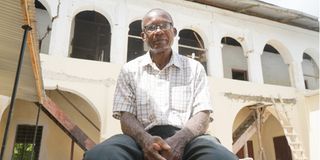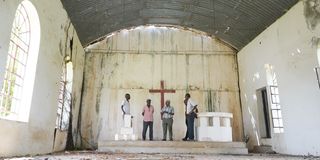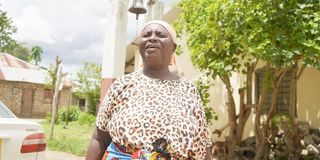Premium
How Tana River community violently fought against Christianity
A sleepy village south of Tana River County is a seat of ancient relics with deep history and mysteries dating back 120 years.
Though a predominantly Christian-centered village, it took bloodshed for missionaries to use Ngao as the launchpad of Christianity in Tana River County due to resistance by the mainly targeted community.
The German missionaries entered Ngao and found two communities - the Pokomo and Orma - comfortably practising their traditional beliefs.
The Pokomo at the time believed in an all-powerful being called "muungu" and ancestral spirits who were a medium between the people and the supreme being.
The Orma were fast adapting to the Islamic faith, having transacted business with the Sultan of Zanzibar, who was determined to stretch his influence past Witu.
"Ngao was on the eastern side of the river then, so the idea of the missionaries was to use the Orma to Christianise people because they had imagined they were the same type they had seen in Ethiopia, the Lutheran kind," said Edward Yese, a Historian and Author of the Book: History of the Pokomo.

Edward Yese, a historian and author during an interview with the nation.africa at the historical missionaries cottage in Ngao Village, Tana River County.
The Orma felt threatened by the spread of the Christian faith and attacked the missionaries several times.
In 1886, they waged a vicious attack against the missionaries in a section of the area known as Golbanti, and despite backing from the Pokomo warriors, who were fast embracing the idea of education and the Biblical God, two missionaries died.
"In May 1886, Rev John Houghton and his wife, Anne, were speared to death by the Orma warriors during the scathing attack, the two fallen missionaries were Christened the Golbanti Martyrs, but that would not be the last attack," said Yese.
The German Lutheran Missionary Society wanted to convert the locals from what they termed a "barbarian lifestyle."

Coast Region Assistant Director of Museums and Monuments National Museum of Kenya Athman Hussein and team during a tour of the 12-decade-old Church built by German Missionaries in Ngao Village, Tana River County.
Hence, the Lutheran Missionary Society sent another missionary, Reverend Ferdinand Wuertz, in March 1887 to continue from where the other two fallen missionaries had left.
"Wuertz was a little bit aggressive because he came and built a temporary building for himself and also built a temporary Church on the battlefield, that was not well conceived by the Orma warriors," narrated Mr Yese.
Wuertz was joined by another missionary, Reverend Weber and his wife, they taught the locals how to read and write as they lured some curious Orma children.
Alarmed by how the Christian faith was fast spreading and how the missionaries were enticing their children and women through the mysterious stick that writes on an empty slate, the Orma waged an attack on the centre, burning the church and its learning material.
"It was then that Reverend Wuertz gave up on luring the Orma, convinced the Pokomo to relocate from the eastern bank of the river to the western bank to avert the frequent attacks," noted Mr Yese.
Also Read: Philip Kinyinga M’Inoti: Behold the reverend, Njuri Ncheke elder and strict colonial chief!
It was not easy convincing the Pokomo to move as they depended on that land.
The missionaries had to help them keep their farms on the eastern side of the river and establish their homes on the western side where Ngao Village currently sits.
The migration would cause tremendous changes in the Pokomo Community.
The Missionaries built a cottage in the areas where they settled and used it as a learning centre to train the Pokomo about the new God of the Holy Bible.
They convinced the Pokomo that faith in their supreme being, "muungu", was a sin and that belief in ancestral spirits was an illusion.
"They trained the Pokomo on lots of things including reading hence the translation of the New Testament to Pokomo, the first Pokomo Dictionary, introduced them to new celebrations like Christmas and even taking oath to serve and obey the new God they taught the Pokomo, they called it conversion," narrated Mr Yese.
Also Read: A fascinating tale of Luo legends
Eight people converted to Christianity, and the number grew bigger.
The Neukrichen staff who manned the station were Ferdinand Wuerts, Weber, Regina Boacking, St Christine Soniteachzen, Sister Eva Velte, Mulholff and Wilk Schmidt.
This development would transform Ngao Village, now known as Ngao London.
The current Kenya Methodist Presiding Bishop, Isaiah Deye, is a fruit of this missionary work, a brainchild of the last missionary to settle on the cottages, Rev Bernard Jenkins.
The cottage, the church and the Ngao Hospital are relics of this beautiful history in the middle of the serene village.
The church, a site with amazing architectural design, is slowly crumbling on its knees, while the hospital is turning into a menace.
The relics that have stood for more than 120 years are fast falling apart due to poor maintenance.
The Regional Assistant Director of Museums and Monuments National Museum of Kenya, Athman Hussein, said: " I feel so sad watching this building falling apart bit by bit, this is a heritage to save, a site to renovate and protect at all costs, unfortunately, to this day, it is not gazetted."
Mr Athman notes that Tana River County is a bed of heritage centres that, if renovated, can be the Bethlehem of Kenya due to its rich history.
He reiterates that the National Museums of Kenya, in partnership with the Methodist Church of Kenya, will gazette more than a century of relics (the missionary house and the church) to continue receiving attention from the Government.
"We believe that by renovating these two buildings, we will open up Ngao and Tana River at large as a host of World War 1 monuments and all this place will become a tourism circuit," he said.
New beginnings
Meanwhile, renovations are ongoing on the missionary's cottage as a step towards establishing the first community museum in the county.
According to the project coordinator William Saka, the renovation exercise has received a boost of 19,500 Euros (Sh2.7 million) through the National Museums of Kenya from Heritage International-Greece.
"We only have funding to renovate the cottage which will be finished by June, and we hope to get more funding to renovate the Church and the hospital among other monuments," he said.
The renovations are following the architectural intelligence with which the building was built.
Mr Philip Jimbi, a heritage consultant currently supervising the renovation, notes materials used in the initial construction must be brought to preserve the precision in quantities and qualities of materials used.
"They never used cement on the walls but lime due to salinity of the soil, if we do otherwise, this building will not stand no matter what, it will be an effort in futility," he said.
Meanwhile, residents in the areas are happy with the ongoing development and only hope that more funding can come for the sake of the church.

Esther Nankuni, a resident, during an interview with nation.africa in Ngao Village, Tana River County.
"When I see the cross on top of the Church hanging on a piece of wood, it pains me, I hope that the government will look at it with the attention it deserves and rescue it, that building is a bunch of memories," said Esther Nankuni.




